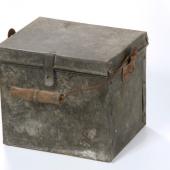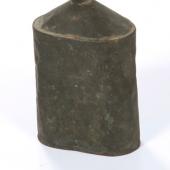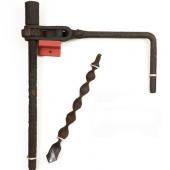
The Foord Pit suffered a terrible explosion in 1880 which killed 44 men. In 1927 a crew opening the Alan Shaft mine tunneled through to the site of the disaster and found the remains of some of the victims and relics like this lamp, its glass fused by the heat of the explosion.

Another relic of the Foord Pit explosion of 1880. This measuring tape was found on the remains of an overman in 1927.

Acetylene lamps came into use in mines in the late nineteenth century. The chemical reaction of water and calcium carbide creates a very bright, clear light. Such lamps are still favoured by cavers.

Thomas Blenkensop’s notebook contains sporadic notes concerning the operations at Albion Mines during the 1860s to the 1880s.
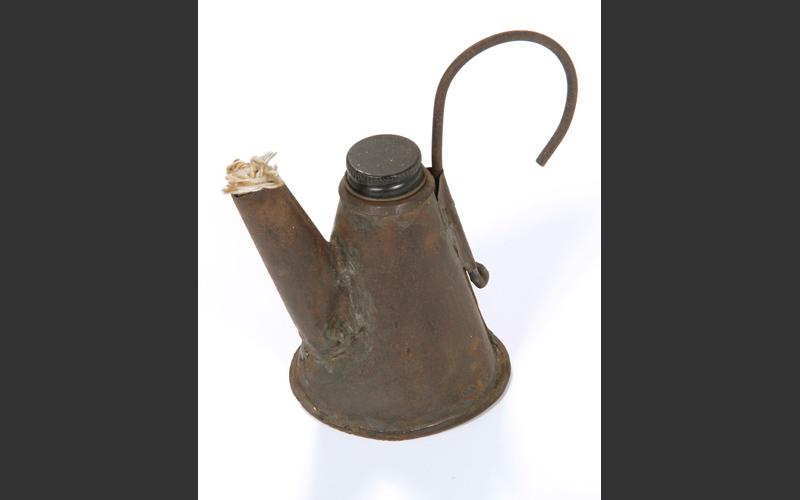
Bicket Lamp: a small oil burning lamp hooked onto the front of a miner’s cap to light his work.

A candle lamp: this was the lighting used in the mines before the development of enclosed kerosene lamps.

Candle-holder: the loop in the center held a candle and the spike in the end allowed it to be driven into a wooden beam to leave the miner’s hands free.
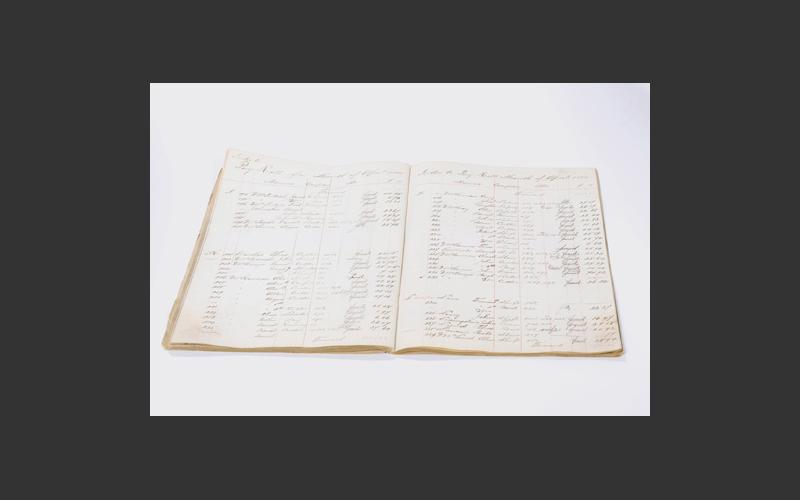
Payroll ledger from Albion Mines covering February to May 1885. It contains the names, occupations and pay rates of men employed in the mine.

Anemometer: An early type of anemometer used in the Bye Pit, one of the earliest local mines. It measured the movement of air in the mine and was an important test of air quality.

The Mine Manager was one of many instructional volumes read by men in the mines to advance their careers. Training by correspondence course was common and they had to pass many levels of written exams.

A later anemometer. The Pictou Co. coal mines are very rich in methane and constant testing of air quality was essential for survival.

Hygrometer: the dual thermometers test for relative humidity. Part of the air quality testing in the mines.

Three kerosene safety lamps. These lamps provided light and also monitored air quality. Their development began in the early nineteenth century and they were in use into the early twentieth century, gradually replaced by electric lights.

Lunch pail: miners took their meals underground so the lunch pail was a very important part of their equipment.

ID tags linked the miner to his lamp. He left his numbered tag in the lamp room when he started his shift.

Electric head lamp with battery pack and leather belt. These became standard equipment in the postwar years and are still in use in modern mines. The lamp hooks onto the front of the miner’s hardhat.

Early version of a miner’s hard hat. It has the mount on the front for his lamp.

A lunch pail bought from Crockett’s store in Westville, Pictou Co.

A more modern lunch can.

A water can, part of a lunch kit, held a miner’s drinking water.

Not a lunch can; this is a shotfirer’s powder box. The shotfirer created controlled explosions in the mine to remove rock and expose the coal.
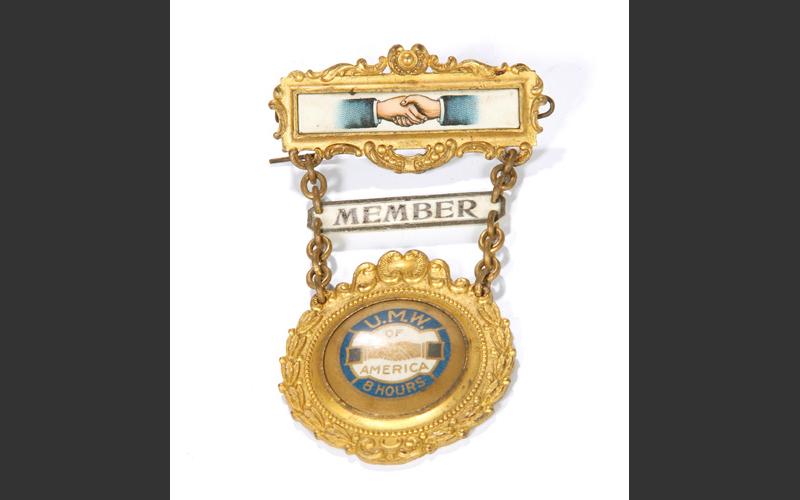
United Mine Workers of America membership badge. The employees of Acadia Coal were part of the international union based in the United States.

Flask for water or tea. In the often very hot, stuffy confines of a mine it was essential to drink enough water.

A battery-powered electric miner’s lamp.
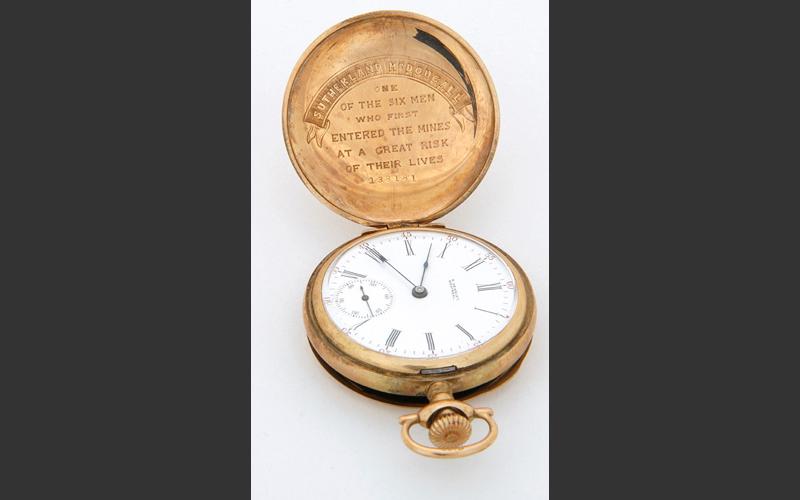
A gold watch presented to Sutherland MacDougall, one of the men who came to the rescue of those trapped by a serious fire in 1913.

A framed photo of the firefighting team at Albion Mines, 1913.

A draegerman’s (mine rescuer) lamp housed in a wooden box.

Coal car (pit tub) used to carry coal from underground to the surface.

A rake: A railcar on which men road down into the mine.

A miner’s pick used to free the coal from rock.

A hand-operated drill used to make a hole to stuff with explosives.

A shovel used in the mine to load coal into coal cars.

A set of breathing apparatus used by miner rescuers, the draegermen, named for a German-made brand of mine rescue equipment.

Close up of the draegerman’s pack with his air supply.

Close up of the draegerman’s mask and breather.

Bellows used in fighting fires.

Mine telephone: among the first uses of telephones was to connect the men underground to the surface.

Brass draegerman’s hammer. The brass head didn’t create spark which could ignite when the air was thick with methane gas.

Early draegerman’s helmet with breathing hoses attached.

A mid-twentieth century draegerman in full rescue gear.

A close up of the draegerman’s mask.

A plaque containing the names of the 26 miners killed in the Westray Mine explosion of May 9, 1992.

The disaster brought help from all parts of the community and the country for which the families of the miners were very grateful. This plaques thanks the Ladies Auxiliaries that helped feed everyone during the crisis.

Plaque thanking the firefighters who were involved with the rescue efforts.

Almost every province in Canada sent mine rescuers to help. With this plaque the Campbell River, BC contingent express their sympathy to the community.

One of the 194 Medals of Honour presented to Westray Mine disaster rescuers by Governor General Roy Hnatyshyn in 1994.
 The Foord Pit suffered a terrible explosion in 1880 which killed 44 men. In 1927 a crew opening the Alan Shaft mine tunneled through to the site of the disaster and found the remains of some of the victims and relics like this lamp, its glass fused by the heat of the explosion.
The Foord Pit suffered a terrible explosion in 1880 which killed 44 men. In 1927 a crew opening the Alan Shaft mine tunneled through to the site of the disaster and found the remains of some of the victims and relics like this lamp, its glass fused by the heat of the explosion. Another relic of the Foord Pit explosion of 1880. This measuring tape was found on the remains of an overman in 1927.
Another relic of the Foord Pit explosion of 1880. This measuring tape was found on the remains of an overman in 1927. Acetylene lamps came into use in mines in the late nineteenth century. The chemical reaction of water and calcium carbide creates a very bright, clear light. Such lamps are still favoured by cavers.
Acetylene lamps came into use in mines in the late nineteenth century. The chemical reaction of water and calcium carbide creates a very bright, clear light. Such lamps are still favoured by cavers. Thomas Blenkensop’s notebook contains sporadic notes concerning the operations at Albion Mines during the 1860s to the 1880s.
Thomas Blenkensop’s notebook contains sporadic notes concerning the operations at Albion Mines during the 1860s to the 1880s. Bicket Lamp: a small oil burning lamp hooked onto the front of a miner’s cap to light his work.
Bicket Lamp: a small oil burning lamp hooked onto the front of a miner’s cap to light his work. A candle lamp: this was the lighting used in the mines before the development of enclosed kerosene lamps.
A candle lamp: this was the lighting used in the mines before the development of enclosed kerosene lamps. Candle-holder: the loop in the center held a candle and the spike in the end allowed it to be driven into a wooden beam to leave the miner’s hands free.
Candle-holder: the loop in the center held a candle and the spike in the end allowed it to be driven into a wooden beam to leave the miner’s hands free. Payroll ledger from Albion Mines covering February to May 1885. It contains the names, occupations and pay rates of men employed in the mine.
Payroll ledger from Albion Mines covering February to May 1885. It contains the names, occupations and pay rates of men employed in the mine. Anemometer: An early type of anemometer used in the Bye Pit, one of the earliest local mines. It measured the movement of air in the mine and was an important test of air quality.
Anemometer: An early type of anemometer used in the Bye Pit, one of the earliest local mines. It measured the movement of air in the mine and was an important test of air quality. The Mine Manager was one of many instructional volumes read by men in the mines to advance their careers. Training by correspondence course was common and they had to pass many levels of written exams.
The Mine Manager was one of many instructional volumes read by men in the mines to advance their careers. Training by correspondence course was common and they had to pass many levels of written exams. A later anemometer. The Pictou Co. coal mines are very rich in methane and constant testing of air quality was essential for survival.
A later anemometer. The Pictou Co. coal mines are very rich in methane and constant testing of air quality was essential for survival. Hygrometer: the dual thermometers test for relative humidity. Part of the air quality testing in the mines.
Hygrometer: the dual thermometers test for relative humidity. Part of the air quality testing in the mines. Three kerosene safety lamps. These lamps provided light and also monitored air quality. Their development began in the early nineteenth century and they were in use into the early twentieth century, gradually replaced by electric lights.
Three kerosene safety lamps. These lamps provided light and also monitored air quality. Their development began in the early nineteenth century and they were in use into the early twentieth century, gradually replaced by electric lights. Lunch pail: miners took their meals underground so the lunch pail was a very important part of their equipment.
Lunch pail: miners took their meals underground so the lunch pail was a very important part of their equipment. ID tags linked the miner to his lamp. He left his numbered tag in the lamp room when he started his shift.
ID tags linked the miner to his lamp. He left his numbered tag in the lamp room when he started his shift. Electric head lamp with battery pack and leather belt. These became standard equipment in the postwar years and are still in use in modern mines. The lamp hooks onto the front of the miner’s hardhat.
Electric head lamp with battery pack and leather belt. These became standard equipment in the postwar years and are still in use in modern mines. The lamp hooks onto the front of the miner’s hardhat. Early version of a miner’s hard hat. It has the mount on the front for his lamp.
Early version of a miner’s hard hat. It has the mount on the front for his lamp. A lunch pail bought from Crockett’s store in Westville, Pictou Co.
A lunch pail bought from Crockett’s store in Westville, Pictou Co. A more modern lunch can.
A more modern lunch can. A water can, part of a lunch kit, held a miner’s drinking water.
A water can, part of a lunch kit, held a miner’s drinking water. Not a lunch can; this is a shotfirer’s powder box. The shotfirer created controlled explosions in the mine to remove rock and expose the coal.
Not a lunch can; this is a shotfirer’s powder box. The shotfirer created controlled explosions in the mine to remove rock and expose the coal. United Mine Workers of America membership badge. The employees of Acadia Coal were part of the international union based in the United States.
United Mine Workers of America membership badge. The employees of Acadia Coal were part of the international union based in the United States. Flask for water or tea. In the often very hot, stuffy confines of a mine it was essential to drink enough water.
Flask for water or tea. In the often very hot, stuffy confines of a mine it was essential to drink enough water. A battery-powered electric miner’s lamp.
A battery-powered electric miner’s lamp. A gold watch presented to Sutherland MacDougall, one of the men who came to the rescue of those trapped by a serious fire in 1913.
A gold watch presented to Sutherland MacDougall, one of the men who came to the rescue of those trapped by a serious fire in 1913. A framed photo of the firefighting team at Albion Mines, 1913.
A framed photo of the firefighting team at Albion Mines, 1913. A draegerman’s (mine rescuer) lamp housed in a wooden box.
A draegerman’s (mine rescuer) lamp housed in a wooden box. Coal car (pit tub) used to carry coal from underground to the surface.
Coal car (pit tub) used to carry coal from underground to the surface. A rake: A railcar on which men road down into the mine.
A rake: A railcar on which men road down into the mine. A miner’s pick used to free the coal from rock.
A miner’s pick used to free the coal from rock. A hand-operated drill used to make a hole to stuff with explosives.
A hand-operated drill used to make a hole to stuff with explosives. A shovel used in the mine to load coal into coal cars.
A shovel used in the mine to load coal into coal cars. A set of breathing apparatus used by miner rescuers, the draegermen, named for a German-made brand of mine rescue equipment.
A set of breathing apparatus used by miner rescuers, the draegermen, named for a German-made brand of mine rescue equipment. Close up of the draegerman’s pack with his air supply.
Close up of the draegerman’s pack with his air supply. Close up of the draegerman’s mask and breather.
Close up of the draegerman’s mask and breather. Bellows used in fighting fires.
Bellows used in fighting fires. Mine telephone: among the first uses of telephones was to connect the men underground to the surface.
Mine telephone: among the first uses of telephones was to connect the men underground to the surface. Brass draegerman’s hammer. The brass head didn’t create spark which could ignite when the air was thick with methane gas.
Brass draegerman’s hammer. The brass head didn’t create spark which could ignite when the air was thick with methane gas. Early draegerman’s helmet with breathing hoses attached.
Early draegerman’s helmet with breathing hoses attached. A mid-twentieth century draegerman in full rescue gear.
A mid-twentieth century draegerman in full rescue gear. A close up of the draegerman’s mask.
A close up of the draegerman’s mask. A plaque containing the names of the 26 miners killed in the Westray Mine explosion of May 9, 1992.
A plaque containing the names of the 26 miners killed in the Westray Mine explosion of May 9, 1992. The disaster brought help from all parts of the community and the country for which the families of the miners were very grateful. This plaques thanks the Ladies Auxiliaries that helped feed everyone during the crisis.
The disaster brought help from all parts of the community and the country for which the families of the miners were very grateful. This plaques thanks the Ladies Auxiliaries that helped feed everyone during the crisis. Plaque thanking the firefighters who were involved with the rescue efforts.
Plaque thanking the firefighters who were involved with the rescue efforts. Almost every province in Canada sent mine rescuers to help. With this plaque the Campbell River, BC contingent express their sympathy to the community.
Almost every province in Canada sent mine rescuers to help. With this plaque the Campbell River, BC contingent express their sympathy to the community. One of the 194 Medals of Honour presented to Westray Mine disaster rescuers by Governor General Roy Hnatyshyn in 1994.
One of the 194 Medals of Honour presented to Westray Mine disaster rescuers by Governor General Roy Hnatyshyn in 1994.



















